America’s First Great Screen Artist, Joseph Boggs Beale
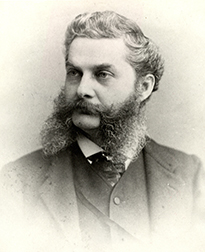
Americans developed a technique for making slides that was rarely used elsewhere in the world: creating a master drawing, photographing it, and then printing slides from the resulting negative. By far the leading practitioner of this technique was Joseph Boggs Beale, who can be considered America’s first great screen artist. He created, almost single-handedly, the early projected entertainment that was manufactured in America.
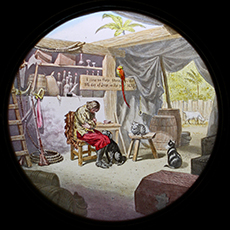
In 1881 Beale began what was to be a 39-year career as the foremost magic-lantern artist in the C. W. Briggs Company, the nation’s leading producer of lantern entertainment. In the period before the movies Beale created screen versions of novels such as Uncle Tom’s Cabin, Ben Hur, and Robinson Crusoe; popular songs like “Home, Sweet Home” and “America”; poetry such as “The Raven” and “The Wreck of the Hesperus”; Bible stories such as “The Prodigal Son” and “The Sower”; hymns such as “Nearer My God to Thee” and “Rock of Ages”; Secret Society and Temperance stories, and hundreds of History and Religious slides.
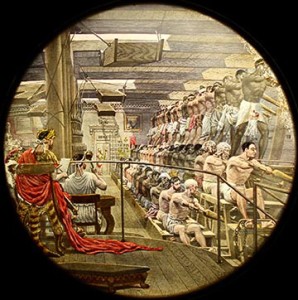
Hur is filled with detail and a host of figures, yet it easy to spot the one oarsman who must be Ben Hur because of the coloring, the lines of the rails, and red cloak’s artful arrow.
Beale developed a special style for screen projection, combining three elements: A dramatic “story-telling image” that drove the action forward; meticulous detail that helped sustain attention while the slides were on screen; and strong designs that led the eye to the main image, even amid the myriad of detail. He employed about 75% of what we now think of as the techniques that make up the “art of the movies”—storyboarding, continuity editing, lighting techniques like key lighting, different points of perspective (camera angles), etc.
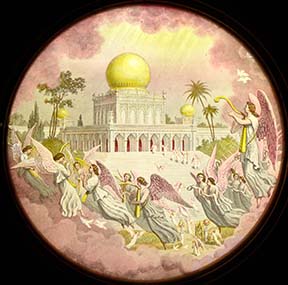
Beale’s master drawings were photographed in the Briggs factory, photographically reduced and printed to an emulsion on glass, and then produced as either b&w or color slides. Briggs might make a hundred slide copies from one of Beale’s master drawings, or a thousand, or ten thousand. These slides were then sold by over a hundred different companies for use in homes, schools, theaters, and in almost every fraternal society and Protestant church in the country.
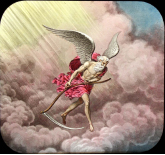
Beale worked for Briggs until the nickelodeon movie craze exploded in 1909 and the market for lantern entertainment collapsed. He continued making lantern designs on a free-lance basis until 1920, creating in his magic-lantern career more than 2,000 master drawings that can be divided into about 250 different sets—the screen-time equivalent of 17 full-length movies. Though they did not know Beale’s name, millions of people a year enjoyed his magic lantern screen entertainment.
Beale died in obscurity in 1926. When his work was re-discovered in the 1930s, it created a sensation. Life Magazine devoted four pages to him, and called him a “great magic lantern artist.”
Recently Beale has again begun to be recognized as a unique and important figure in the history of American cinema and art. His work is now held by the following museums and institutions: The Academy of Motion Picture Arts and Sciences, Harvard University, The George Eastman House International Museum of Photography and Film, Duke University, The Brandywine River Museum, The Center for American Music, The Philadelphia Museum of Art, The Atwater-Kent Museum, The Magic-Lantern Castle Museum, The Henry Ford Museum, The New Britain Museum of American Art, The Rosenberg Library and Museum, The Museum of the Moving Image (New York), The R. W. Norton Art Gallery, The Kent Museum of the Moving Image (England), The Wadsworth Atheneum, The Richard Balzer Collection, The Library of Congress, Baylor University, and The Whitney Museum of American Art.
All images © The Beale Collection. All rights reserved.